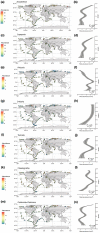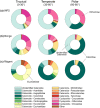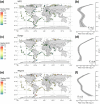Macroscale patterns of oceanic zooplankton composition and size structure
- PMID: 34344925
- PMCID: PMC8333327
- DOI: 10.1038/s41598-021-94615-5
Macroscale patterns of oceanic zooplankton composition and size structure
Erratum in
-
Author Correction: Macroscale patterns of oceanic zooplankton composition and size structure.Sci Rep. 2021 Oct 6;11(1):20226. doi: 10.1038/s41598-021-99772-1. Sci Rep. 2021. PMID: 34615992 Free PMC article. No abstract available.
Abstract
Ocean plankton comprise organisms from viruses to fish larvae that are fundamental to ecosystem functioning and the provision of marine services such as fisheries and CO2 sequestration. The latter services are partly governed by variations in plankton community composition and the expression of traits such as body size at community-level. While community assembly has been thoroughly studied for the smaller end of the plankton size spectrum, the larger end comprises ectotherms that are often studied at the species, or group-level, rather than as communities. The body size of marine ectotherms decreases with temperature, but controls on community-level traits remain elusive, hindering the predictability of marine services provision. Here, we leverage Tara Oceans datasets to determine how zooplankton community composition and size structure varies with latitude, temperature and productivity-related covariates in the global surface ocean. Zooplankton abundance and median size decreased towards warmer and less productive environments, as a result of changes in copepod composition. However, some clades displayed the opposite relationships, which may be ascribed to alternative feeding strategies. Given that climate models predict increasingly warmed and stratified oceans, our findings suggest that zooplankton communities will shift towards smaller organisms which might weaken their contribution to the biological carbon pump.
© 2021. The Author(s).
Conflict of interest statement
The authors declare no competing interests.
Figures






References
-
- Litchman E, Ohman MD, Kiørboe T. Trait-based approaches to zooplankton communities. J. Plankton Res. 2013;35:473–484. doi: 10.1093/plankt/fbt019. - DOI
-
- Bergmann C. Über die Verhältnisse der Wärmeökonomie der Thiere zu ihrer Grösse. Göttinger Studien. 1847;3:595–708.
Publication types
LinkOut - more resources
Full Text Sources

